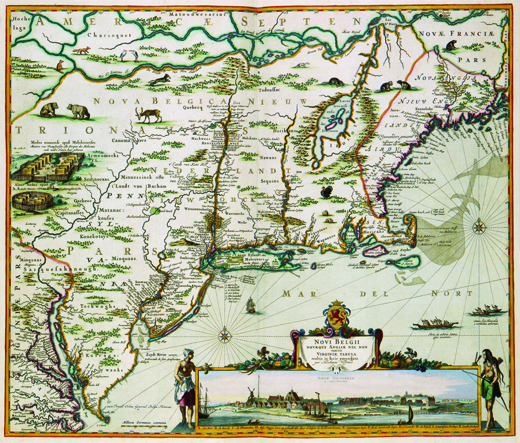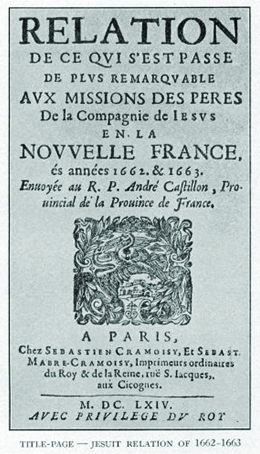| << Chapter < Page | Chapter >> Page > |

The Dutch West India Company found the business of colonization in New Netherland to be expensive. To share some of the costs, it granted Dutch merchants who invested heavily in it patroonships , or large tracts of land and the right to govern the tenants there. In return, the shareholder who gained the patroonship promised to pay for the passage of at least thirty Dutch farmers to populate the colony. One of the largest patroonships was granted to Kiliaen van Rensselaer, one of the directors of the Dutch West India Company; it covered most of present-day Albany and Rensselaer Counties. This pattern of settlement created a yawning gap in wealth and status between the tenants, who paid rent, and the wealthy patroons.
During the summer trading season, Indians gathered at trading posts such as the Dutch site at Beverwijck (present-day Albany), where they exchanged furs for guns, blankets, and alcohol. The furs, especially beaver pelts destined for the lucrative European millinery market, would be sent down the Hudson River to New Amsterdam. There, slaves or workers would load them aboard ships bound for Amsterdam.
Explore an interactive map of New Amsterdam in 1660 that shows the city plan and the locations of various structures, including houses, businesses, and public buildings. Rolling over the map reveals relevant historical details, such as street names, the identities of certain buildings and businesses, and the names of residents of the houses (when known).
After Jacques Cartier’s voyages of discovery in the 1530s, France showed little interest in creating permanent colonies in North America until the early 1600s, when Samuel de Champlain established Quebec as a French fur-trading outpost. Although the fur trade was lucrative, the French saw Canada as an inhospitable frozen wasteland, and by 1640, fewer than four hundred settlers had made their home there. The sparse French presence meant that colonists depended on the local native Algonquian people; without them, the French would have perished. French fishermen, explorers, and fur traders made extensive contact with the Algonquian. The Algonquian, in turn, tolerated the French because the colonists supplied them with firearms for their ongoing war with the Iroquois. Thus, the French found themselves escalating native wars and supporting the Algonquian against the Iroquois, who received weapons from their Dutch trading partners. These seventeenth-century conflicts centered on the lucrative trade in beaver pelts, earning them the name of the Beaver Wars. In these wars, fighting between rival native peoples spread throughout the Great Lakes region.
A handful of French Jesuit priests also made their way to Canada, intent on converting the native inhabitants to Catholicism. The Jesuits were members of the Society of Jesus, an elite religious order founded in the 1540s to spread Catholicism and combat the spread of Protestantism. The first Jesuits arrived in Quebec in the 1620s, and for the next century, their numbers did not exceed forty priests. Like the Spanish Franciscan missionaries, the Jesuits in the colony called New France labored to convert the native peoples to Catholicism. They wrote detailed annual reports about their progress in bringing the faith to the Algonquian and, beginning in the 1660s, to the Iroquois. These documents are known as the Jesuit Relations ( [link] ), and they provide a rich source for understanding both the Jesuit view of the Indians and the Indian response to the colonizers.
One native convert to Catholicism, a Mohawk woman named Katherine Tekakwitha, so impressed the priests with her piety that a Jesuit named Claude Chauchetière attempted to make her a saint in the Church. However, the effort to canonize Tekakwitha faltered when leaders of the Church balked at elevating a “savage” to such a high status; she was eventually canonized in 2012. French colonizers pressured the native inhabitants of New France to convert, but they virtually never saw native peoples as their equals.
The Jesuit Relations ( [link] ) provide incredible detail about Indian life. For example, the 1636 edition, written by the Catholic priest Jean de Brébeuf, addresses the devastating effects of disease on native peoples and the efforts made to combat it.

Let us return to the feasts. The Aoutaerohi is a remedy which is only for one particular kind of disease, which they call also Aoutaerohi , from the name of a little Demon as large as the fist, which they say is in the body of the sick man, especially in the part which pains him. They find out that they are sick of this disease, by means of a dream, or by the intervention of some Sorcerer. . . .
Of three kinds of games especially in use among these Peoples,—namely, the games of crosse [lacrosse], dish, and straw,—the first two are, they say, most healing. Is not this worthy of compassion? There is a poor sick man, fevered of body and almost dying, and a miserable Sorcerer will order for him, as a cooling remedy, a game of crosse. Or the sick man himself, sometimes, will have dreamed that he must die unless the whole country shall play crosse for his health; and, no matter how little may be his credit, you will see then in a beautiful field, Village contending against Village, as to who will play crosse the better, and betting against one another Beaver robes and Porcelain collars, so as to excite greater interest.
According to this account, how did Indians attempt to cure disease? Why did they prescribe a game of lacrosse? What benefits might these games have for the sick?
The French and Dutch established colonies in the northeastern part of North America: the Dutch in present-day New York, and the French in present-day Canada. Both colonies were primarily trading posts for furs. While they failed to attract many colonists from their respective home countries, these outposts nonetheless intensified imperial rivalries in North America. Both the Dutch and the French relied on native peoples to harvest the pelts that proved profitable in Europe.

Notification Switch
Would you like to follow the 'U.s. history' conversation and receive update notifications?